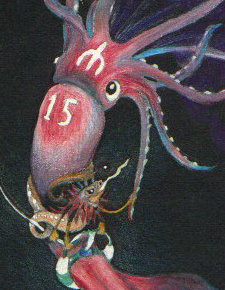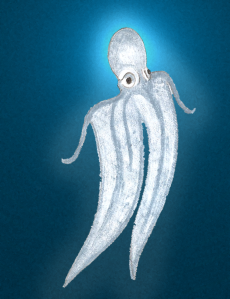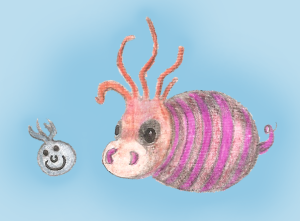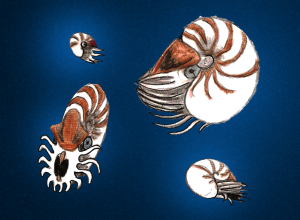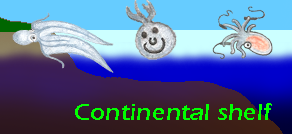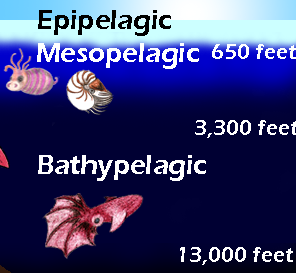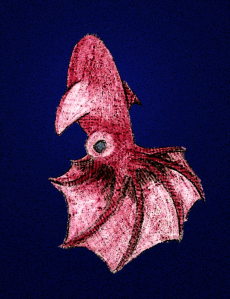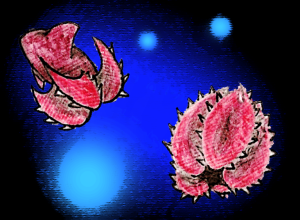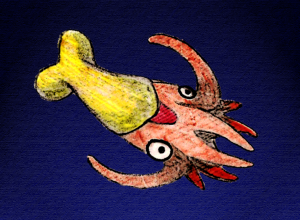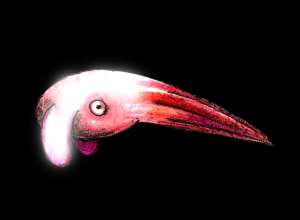Dear Human,
It’s not Ruke this time.
It’s Fron.
Ruke gets all of the attention because he is so smart,
but Ruke doesn’t have a magic helmet.
I do.
I found it in an ancient, underwater city while on one of my many adventures.
The helmet gives me the power to control giant squid!
I also have a set of gloves that let me control baseballs –
and a pair of tennis shoes with powers I haven’t figured out yet.
I travel all of the time and have mud forts in all the world’s oceans!
I was voted most likely to get eaten by the class of 2012.
I am also a cephalopod expert.
Cephalopods are squid, octopuses, and all other tentacled creatures – except jellyfish.
I would like to show you nine, awesome cephalopods.
I will start in the epipelagic zone!
The epipelagic zone is the first 200 meters or 650 feet of water on the ocean’s surface.
It takes a lot of training for a Pokian like me to survive way up here and I can not stay for very long.
Ruke told me to use his ultra marine because Ruke likes doing things the easy way.
Ruke is a nerd.
I will start near a corral reef that is about a kilometer from the shore.
I will not go too close to the reef because I’m told it is filled with killer blue ringed octopuses.
The blue ringed octopus is only 12 to 20 centimeters (5 to 8 inches) long, but it is the most dangerous octopus there is.
It’s bite is like a king cobra’s, and just one of these little sea monsters has enough poison to kill 26 humans!
It’s said to hide in reefs and tide pools where it eats small crustaceans like shrimp and hermit crabs.
It lives near the Pacific and Indian oceans from Japan to Australia.
So if you live in one of these places, watch out!
Because my magic helmet only controls giant squid, octopuses are still dangerous to me.
Let’s look for something safer.
AAAAHHHH!
A ghost!
Oh, wait a minute.
This is just a blanket octopus.
I must have startled her.
Instead of squirting ink in your face like other octopuses, the blanket octopus unrolls her long, flat tentacles to make herself look bigger and scarier.
With her big cape, she can be over 2 meters (about six feet) long.
A hungry shark might think, “AHHH! A ghost!” and swim away.
I don’t see many blanket octopuses in the deeps.
They live on the surface where the water is warm.
You can find blanket octopuses all over the warmer parts of the world!
What is this?
Awe.
This blanket octopus must be a baby.
It’s only a few centimeters long.
Where’s your blanket, Little Baby?
Actually, this is just what a boy blanket octopus looks like.
Sorry Ruke, but I think I’ve found an even bigger nerd then you.
Wait, what’s he holding?
AHH! Those are the tentacles of a deadly, Portuguese man of war jellyfish!
How is he not getting stung!?
Don’t hit me with those tentacles little guy! I won’t eat you, I promise!

The Portuguese man of war is not actually a jellyfish. It is a clump of smaller animals called a siphonophore. Its sting is different from a jellyfish and requires different first aid.
Everything wants to kill me up here! How do you humans stand it!
I’ll probably find something nicer in the mesopelagic zone.
The mesopelagic zone is right under the epipelagic zone.
Something in the mesopelagic zone is over 200 meters (650 feet) underwater.
Here, I can escape from the dangerous stuff and say hi to a banded piglet squid.
The banded piglet squid is about 12 centimeters, (5 inches) long.
The blue smiley face is a baby piglet squid.
The babies usually float on the ocean surface, but the grown-ups live in the mesopelagic zone.
The mouth of this squid is actually on top of its head under its tentacle hair.
The smile of the baby squid is actually a stripe on its back.
These two little squids are swimming upside down.
They probably move by shooting water out of their big noses.
By now you have probably stopped believing these things actually exist, but I assure you – they are realer then me.
These squid are so cute I fear I might eat them if I stay up here too long.
I will leave our friends and explore the depths on the edge of the reef.
A creature lives here that is part squid and part snail!
This is the nautilus. You might as well be looking at the last dinosaur!
Squids and octopuses and nautiluses are related to snails,
but only nautiluses have a snail-shell.
In the time of dinosaurs, there were many nautiluses.
Now only a few a small nautiluses are left.
Nautiluses live in the Indo-Pacific Ocean. The Indo-Pacific Ocean is the Indian Ocean and a large chunk of the southwestern Pacific Ocean.
It contains Hawaii and the Philippines. Nautiluses live here, in the deeper parts of coral reefs.
Nautiluses eat just about anything they can find.
They pull their heads into their shells like turtles when frightened and have over a hundred, sticky tentacles.
They also live longer then other cephalopods (about twenty years).
Their beautiful shells can fit neatly into a human hand, or can be as large as a dinner plate.
The shells are often seen for sale in gift shops.
The inside of the shell is covered in silvery stuff that is used to make jewelry.
Please don’t buy nautilus shells.
You probably think people just find them on beaches, so did I, but I can’t help but notice my stripey friends are getting harder and harder to find.
There used to be a hundred here and now I only see four.
I wish I could hide these under my bed but I know their hollow shells would collapse like little submarines if I tried to bring then down to the ocean floor with me.
A nautilus can only survive above 800 meters. This is (about 2,400 feet) from the surface.
I will just have to check on these whenever I can.
If I return, and these four nautiluses are still where I left them.
I will thank you.
Now I will leave the reef and head for the edge of the continental shelf.
The continental shelf is a plain of shallower ocean near the shore. It is usually no deeper then a kilometer (3,250 feet).
There is sometimes a big cliff at the edge of the shelf. Beyond this cliff, the ocean can be over 4 kilometers deep.
That is 13,000 feet, over 2 miles!
The water is so dark I can barely see the edge of the cliff as I swim past it.
Slowly, carefully, I start to swim down.
The light on my forehead and my glowing finger tips are all I can see now.
The slopes below the continental shelf are where the giant squid hangs out!
The giant squid lives in the bathypelagic zone.
People call it the dark or the midnight zone because sunlight can’t reach this far down.
Something is said to be in the Bathypelagic zone when it is at least 1,000 meters (3,250 feet) underwater.
Because the giant squid likes to live near the underwater cliffs at the edge of the continental shelf, you can find them in any part of the ocean where a continental shelf exists!
It is very, very, very, hard to find giant squid, though.
I summoned this one with the power of my squid-controlling, magic helmet!
See how big it is! Its body must be at least 5 meters, that’s 16 feet long! Look at the tentacles!
Together with the long tentacles it must be up to 14 meters! (46 feet)
It’s so big, I can’t see all of it at once! My head light only shows me a meter at a time.
Right now, I’m looking at a giant eye! The eye is as big as a Frisbee!
Giant squid catch food with their two longest arms. The arms are covered in claws.
I like to stay away from those arms.
My helmet protects me from becoming a snack but humans don’t need to fear giant squid.
Unlike the killer blue ringed octopus, the giant squid lives far away from people.
Few people will ever even see a giant squid, unless those people are in a submarine or a dead squid washes up on a beach.
For that reason, you shouldn’t have to worry about giant squid attacking you at the beach.
Giant squid, however, have to worry about sperm whales!
Whales breathe air like humans but sperm whales can hold their breath long enough to dive down deep and snatch a giant squid!
Giant Squid are full of a chemical that keeps them from sinking.
This chemical is said to taste like salty licorice. Giant squid are rubbery – just like licorice!
Licorice is a candy that tastes nasty to most people, but sperm whales must like it.
I need to get out of here before a sperm whale shows up and mistakes me for something to eat!
I’m much smaller then a giant squid so that poor whale would certainly still be hungry afterwards.
Down I go!
Let’s find a vampire squid!
Ever wonder what a squid would look like if it had webbed tentacles!
Wonder no more!
The vampire squid is called a squid but it is something entirely different from a squid or an octopus.
It seems like it is part squid and part octopus.
No one can figure out which it is, so people put it in it’s own group.
It is called a vampire squid only because it looks scary.
It doesn’t suck blood.
It eats little bits of stuff it finds floating around.
It is afraid of everything.
The vampire squid is a very slow swimmer and often can’t outrun the things that want to eat it.
It is only 30 centimeters (a foot) long and would probably make a tasty snack for a giant squid.
What’s it doing now?
Looks like I scared it.
The vampire squid can squirt a glow-in-the-dark ink cloud!
The ink cloud is full of specks that look like fireflies.
Now it’s going to turn itself inside-out until I leave,
becoming a spiny ball.
Now I’ll show you something so special that only one of them has ever been caught by humans.
Promachoteuthis Sulcus are two big words I can’t say.
They are the name of a tiny squid with a very weird face.
I will empty the crumbs from my lunch bag so it can eat the scraps.
Watch as it comes over to eat the crumbs.
It has people teeth!
They look so clean!
I wonder if it uses its 10 tiny arms to hold 10 tiny toothbrushes!
Fooled ya!
Those are not teeth at all.
They just look like teeth.
Those are the squid’s lips.
It and all squids and octopuses have parrot beaks instead of teeth.
It’s beak is behind the teeth lips.
Polly want a cracker!
Humans only have one of these squid, and it’s dead.
They found it in the South Atlantic ocean near the island of Tristan da Cunha.
I have seen many of these squid in this part of ocean.
They are usually about 25 millimeters (one inch) long.
They live at depths of 1,750 to 2,000 meters. (5,740 – 6,600 feet)
If you think that is deep, wait for this next one!
The long armed squid is also called the big fin squid or the elbow squid. It lives in the abyssopelagic zone.
Things in the abyssopelagic zone are at least 4,000 meters (13,000) feet from the surface.
Because it lives so deep, the big fin squid has been discovered only recently by explorers in submarines.
The big fin squid can be 7 meters, (23 feet) long, with its long tentacles fully stretched out.
The tentacles seem to have elbows that zig and zag.
The tentacles are very sticky and sometimes get stuck to the submarines that are watching the squid.
When these squid get tangled in my hair, they panic and bounce around a lot.
It’s annoying.
It’s hard to pull them off without hurting them, so I try to keep my distance.
I think the big fin squids use their sticky tentacles to catch food but when they encounter something bigger then themselves, it kind of backfires on them.
At 5 kilometers (about 16,250 feet), I‘ve finally reached the deep ocean floor.
The depth of the ocean can be different in different places.
It depends on whether there is a mountain or a canyon below you.
Most of the ocean floor is flat, though. These flat places are called abyssal plains.
I made a tent next to a canyon. A canyon on the edge of the abyssal plains.
The canyon is too deep even for a creature like me.
Canyons and valleys on the ocean floor are called trenches.
In these trenches, is the hadopelagic zone.
The deepest depth in all the oceans is in the Mariana Trench.
The water is 10,898 meters (35,755 feet) deep at a point called Challenger Deep.
That’s almost nine kilometers, or seven miles!
My trench may not be the Mariana Trench, but it’s still pretty extreme.
There is something that lives down in this trench, though,
something that keeps stealing my food.
Here it comes now!
This is a Dumbo octopus!
I bet you have never seen an octopus with lipstick!
This Dumbo octopus is almost two meters (6 feet) long.
She is a giant.
Most Dumbo octopuses are smaller.
Dumbo octopuses are the deepest dwelling octopuses!
Some can live as deep as 7 kilometers (roughly 4 and one-third miles or 23,000 feet)!
They like crunchy things like crabs and shrimp.
A Dumbo octopus can swallow a crab whole!
Why is it called a Dumbo octopus?
“Boo!”
I startled her.
Now she looks just like a little, pink elephant!
I find it even weirder that she seems to have a boat propeller for a face.
Well, that is the end of “Fron‘s Giant, Giant Squid Page”
but I’m sure there are even more strange squids out there
and countless other animals
waiting to be discovered!


